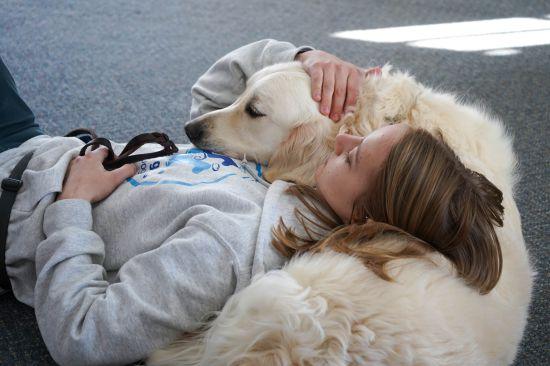In a world where mental health awareness is on the rise, the invaluable role of psychiatric service dogs is gaining increased recognition. These specially trained companions offer not just support, but a vital lifeline to individuals grappling with conditions such as anxiety, PTSD, and depression. As more people discover the profound benefits of having a psychiatric service dog by their side, the search for professional and effective training programs has become a priority. Whether you’re a prospective handler or simply curious about how these remarkable dogs can enhance emotional well-being, this article will guide you through the essentials of finding reputable psychiatric service dog training near you. Join us as we explore the intersection of companionship and recovery, unlocking the transformative potential of the human-animal bond.
Table of Contents
- Understanding the Role of Psychiatric Service Dogs in Mental Health Support
- Finding Local Resources for Effective Training Programs
- Essential Training Techniques for Psychiatric Service Dogs
- Evaluating the Best Trainers and Facilities Near You
- Q&A
- In Summary
Understanding the Role of Psychiatric Service Dogs in Mental Health Support
Psychiatric service dogs (PSDs) play a vital role in supporting individuals with mental health conditions by providing both companionship and practical assistance. These specially trained canines are equipped to perform a variety of tasks tailored to their handler’s specific needs. Some of the key functions of psychiatric service dogs include:
- Grounding Techniques: Helping individuals experiencing anxiety or panic attacks to reground themselves through physical presence.
- Medication Reminders: Alerting their handlers when it’s time to take medication.
- Behavioral Intervention: Interrupting harmful behaviors such as self-harm or compulsive repetition.
- Social Support: Easing social interactions for those who struggle with social anxiety.
These remarkable dogs are more than just pets; they are trained to recognize subtle changes in their handler’s emotional state and respond appropriately. This can lead to significant enhancements in the quality of life for those who rely on them. As such, it is essential to understand the training process involved, which typically includes:
| Training Component | Description |
|---|---|
| Obedience Training | Foundation of good behavior and responsiveness. |
| Task-Specific Training | Learn behaviors that assist their handlers during crises. |
| Socialization | Exposure to various environments and situations to mitigate anxiety. |
Finding Local Resources for Effective Training Programs
When searching for effective training programs tailored to psychiatric service dogs, it’s essential to tap into local resources that understand the unique needs of these service animals. Many communities offer specialized training schools that not only focus on obedience and commands but also incorporate techniques for alleviating anxiety and providing emotional support. Some key resources to explore include:
- Local Veterinary Clinics: Often have references for trainers with experience in service dog training.
- Pet Training Centers: Look for centers that specifically mention service dog training in their curriculum.
- Veteran and Disability Support Organizations: They may provide insights or partnerships with trainers familiar with psychiatric needs.
- Online Community Forums: Local Facebook groups or support websites can be great for recommendations and shared experiences.
In addition to these resources, considering the structure and elements of the training programs is crucial. A well-rounded program should involve not just hands-on training but also educational components for the handler. Below is a table summarizing essential aspects to look for in these programs:
| Program Element | Description |
|---|---|
| Hands-on Sessions | Practical training exercises with the dog. |
| Handler Education | Information on managing the dog’s behavior and well-being. |
| Socialization Activities | Encounters with different environments and people. |
| Ongoing Support | Access to resources or follow-up consultations post-training. |
Essential Training Techniques for Psychiatric Service Dogs
The journey of training a psychiatric service dog is both rewarding and intricate. A well-trained dog not only provides emotional support but also assists individuals in managing the symptoms of mental health conditions. To achieve this, it’s vital to focus on essential techniques that help forge a deep bond between the handler and the dog. Consider these core methods:
- Positive Reinforcement: Rewarding your dog with treats, praise, or playtime encourages desired behaviors.
- Socialization: Expose your dog to a variety of situations, people, and environments to foster confidence and adaptability.
- Task Training: Teach specific tasks that mitigate the handler’s anxiety, such as alerting to panic attacks or providing deep pressure therapy.
- Consistent Commands: Use clear, consistent commands; this aids in better communication and understanding between the dog and handler.
Incorporating these techniques allows handlers to develop a deeper understanding of their dogs while catering to their unique needs. Establishing a structured routine can further aid in effective training. Here’s a simple framework to guide your training schedule:
| Time | Activity | Duration |
|---|---|---|
| 8:00 AM | Morning Walk | 20 mins |
| 9:00 AM | Training Session | 30 mins |
| 12:00 PM | Socialization | 30 mins |
| 3:00 PM | Task Practice | 30 mins |
| 6:00 PM | Cool Down Time | 15 mins |
Evaluating the Best Trainers and Facilities Near You
Finding the right trainers and facilities for psychiatric service dog training in your area is crucial for ensuring that both you and your canine companion receive the best possible support. As you explore your options, consider the following important factors when evaluating training programs:
- Credentials: Look for trainers who hold certifications from reputable organizations focusing on service dogs.
- Experience: Seek out facilities with trainers who have extensive experience working with psychiatric service animals.
- Training Methods: Evaluate the training techniques employed, ensuring they are humane, positive reinforcement-based approaches.
- Facility Environment: Consider the setting where training occurs; it should be safe, clean, and conducive to learning.
- Client Testimonials: Research reviews from previous clients to gauge their satisfaction and their dogs’ progress.
To further assist in your search, here’s a simple comparison table showcasing some local training options based on key aspects:
| Facility Name | Location | Training Approach | Client Rating |
|---|---|---|---|
| Pawsitive Minds | Downtown | Positive Reinforcement | 4.8/5 |
| Service Dog Academy | East Side | Customizable Plans | 4.5/5 |
| Bark and Bond | West End | Holistic Approaches | 4.6/5 |
By taking the time to assess these aspects, you can confidently select a trainer and facility that aligns with your specific needs and those of your psychiatric service dog, fostering a successful training journey.
Q&A
Q&A: Finding Psychiatric Service Dog Training Near You
Q1: What is a psychiatric service dog?
A: A psychiatric service dog (PSD) is specifically trained to assist individuals with mental health conditions such as PTSD, anxiety, depression, or other emotional challenges. These dogs provide support by helping their handlers navigate daily life, manage symptoms, and provide emotional comfort.
Q2: How do I know if I need a psychiatric service dog?
A: If you find that your mental health condition significantly interferes with your daily activities, relationships, or overall quality of life, a psychiatric service dog may be an appropriate option. It’s important to consult with a mental health professional to discuss your symptoms and explore whether a PSD could be beneficial for you.
Q3: What should I look for in a local training program for psychiatric service dogs?
A: When searching for a training program, consider the following factors:
- Certification: Look for programs accredited by organizations that specialize in service dog training.
- Experience: Trainers should have experience working specifically with psychiatric service dogs and understanding mental health.
- Training Methods: Ensure the program employs positive reinforcement techniques and focuses on the unique tasks PSDs must learn, such as grounding or interrupting harmful behaviors.
- Recommendations: Seek reviews or testimonials from other clients to gauge the program’s effectiveness and reputation.
Q4: How long does it typically take to train a psychiatric service dog?
A: The training duration can vary widely based on individual needs, the dog’s temperament, and the complexity of the tasks required. Generally, a training program can last anywhere from 6 months to 2 years. It may also include follow-up training and support to reinforce learned behaviors.
Q5: Can I train my own psychiatric service dog?
A: Yes, it is possible to train your own PSD, but it requires a deep understanding of both training methodologies and the specific needs associated with your mental health condition. It’s recommended to collaborate with a professional trainer or utilize reputable resources to ensure your dog develops the necessary skills.
Q6: What kind of tasks will a psychiatric service dog be trained to perform?
A: Psychiatric service dogs can be trained to perform specific tasks such as:
- Deep pressure therapy: Providing physical comfort during anxiety or panic attacks.
- Medication reminders: Alerting you when it’s time to take your medication.
- Grounding techniques: Guiding you back to the present when experiencing dissociation or overwhelming emotions.
- Assessing environment: Helping to detect and mitigate anxiety triggers in a public setting.
Q7: What is the difference between a therapy dog and a psychiatric service dog?
A: Therapy dogs provide emotional support to multiple individuals in locations like hospitals or schools and are not considered service animals under the ADA (Americans with Disabilities Act). In contrast, psychiatric service dogs are trained to perform specific tasks that assist an individual with their mental health challenges, giving them rights and access as recognized service animals under the ADA.
Q8: Are there any financial considerations when looking for training?
A: Yes, costs can vary significantly based on the program, location, and specific services offered. Be sure to inquire about payment plans, scholarships, or community resources that might help alleviate some financial burden. Additionally, some organizations may offer grants for those who require financial assistance to obtain a psychiatric service dog.
Q9: How can I get started with the process?
A: Begin by researching local training programs, consulting mental health professionals, and identifying specific needs that a psychiatric service dog would address for you. Engaging with local disability rights organizations can also provide support, resources, and recommendations for trustworthy training services nearby.
Q10: What are the next steps after training is complete?
A: Once training is complete, it’s essential to maintain a consistent routine with your PSD. Continued training, socialization, and reinforcement of skills will be important as you integrate your dog into your daily life. Joining a support group for individuals with service dogs can also provide valuable community and ongoing resources as you navigate this new chapter in your life.
By addressing these common questions, we hope to provide clarity and resources for those interested in psychiatric service dogs and their training. As you embark on this journey, remember that the companionship and support of a well-trained PSD can be a transformative experience.
In Summary
the journey of finding the right psychiatric service dog training near you is not only about locating a facility but also about nurturing a partnership that promotes healing and understanding. As you explore your options, remember that the right program can significantly enhance the bond between you and your service dog, paving the way for a more balanced and fulfilling life. Whether you’re seeking assistance for anxiety, PTSD, or any other mental health challenge, taking that first step toward training can mark the beginning of a transformative journey. Embrace the process, stay informed, and choose wisely. Your future companion may very well be the key to unlocking new possibilities in your life.



